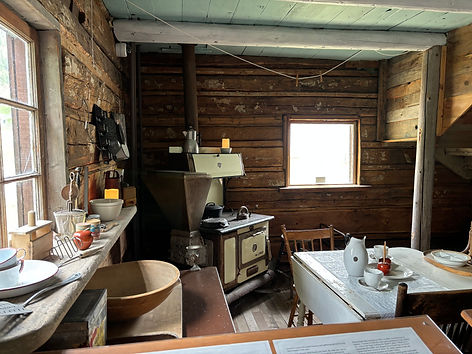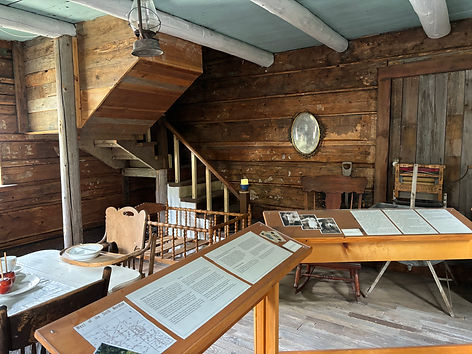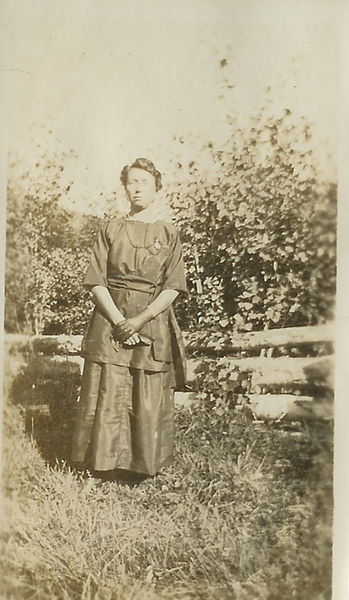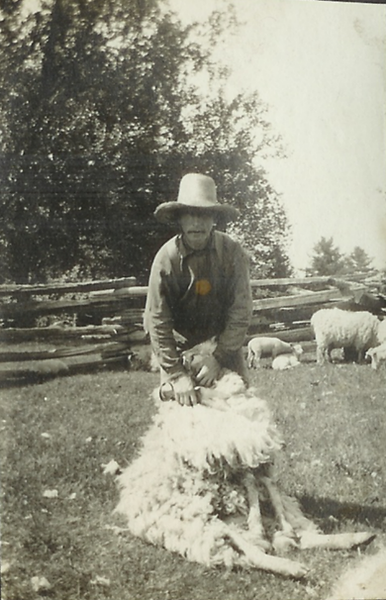
The Chase & District
Museum & Archives

Laviolette Cabin
The historic cabin located on the Chase Museum property originally belonged to the Laviolette family. It was built around 1912 and donated to the Museum in 2007. With the assistance of many individuals and groups we were able to move the cabin here to rest on a new concrete foundation.
Due to the climate of this region and the fact that the cabin is not heated, it is only open to visitors in the Spring and Summer months. If you are viewing this page and the cabin is not open, keep scrolling to see photographs and copies of the signage inside!
The Chase & District Museum & Archives Society wishes to acknowledge and thank the following:
-
Jorgen & Alice Baltsersen (donation of cabin)
-
Vic Skjeie
-
David Lepsoe
-
Danny Mattey of Mattey Bros. Ltd.
-
Bob McClellan
-
Keith Ulley of Keeger Equipment Sales
-
Robin Young of Adams Lake Towing
-
Art Osbourne
-
Gunter Von Lienen of Adams Lake Lumber
-
Randy Trouse of Eagle West Cranes
-
Brad Propochuck of Turtle Valley Gravel Products
-
Vic Pages & Citizens on Patrol
-
Vicki Skjeie-Dawson & traffic controller team
-
Roger Behn
-
Public Works Crew
-
Village of Chase


English Signage
Richard and Sarah
Much of the history connected to this Turtle Valley homestead cabin comes from an oral tradition. Stories have been passed on from Sarah and Dick Lovelette to their children and grandchildren. Like bookends, information stored in the National Archives and BC Archives and Records Service confirms a range of dates in the family's oral history.
Although they had been a couple for years, Sarah and Dick officially married in 1901.* The 1911 census shows them living in Turtle Valley with children Eva (Evelina), Lottie (Charlotte), and George. Sarah's grandson Napoleon DeLeenheer and cousin (?) Beatrice Laurence also lived with the family. Four years after the census was taken, Richard "Lovellep" completed his homestead claim on the NE quadrant of section 26, Township 21, Range 12, West of the 6th M. in 1915. Few other government documents have survived.
*We would be remiss if Sarah's previous marriages were not noted. At 18 she had a relationship with Daniel Foster and a daughter, Annie, was born in 1874. Later, Sarah's father gave her and three sisters to different westerners in marriage. Sarah's country marriage to Donald Grant McPherson resulted in two daughters, Alice and Lizzie (Mary-Ann). According to author Joyce Dunn, Sarah left McPherson for undisclosed reasons and her three daughters remained with him. McPherson moved to Pinantan to ranch there. Alexander Porteous was Sarah's next husband and the two had a daughter, Florence Blanch(e). Porteous moved to the West side of Okanagan Lake, married another woman, and appears on the voter's list in 1898.
Family members give us insight into what brought the couple together. Richard Laviolette was born in Cornwall, Ontario and worked for the Canadian Pacific Railway. Family legend has it that Richard was on the crew that drove the last spike at Craigellachie. With his employment ending in 1885, the French descendant made it to Notch Hill, the Canadian Pacific Railway settlement, near Salmon Arm. Western Land Grants were being offered to both C. P. R. employees and settlers. The country was young, the Shuswap needed clearing, and Richard Laviolette was interested.
The couple's descendants tell us that the land in Turtle Valley was a special place and a traditional land of the Secwepemc, the First Peoples of the area. Dick was interested in one special woman. Her name was Cinmenak. Settlers bestowed a nickname on her, Buckskin Sally. She was Secwepemc and a members of the Shuswap (Neskonlith) band, a sister-in-law to Whitfield Chase, and she knew the land. The meadow adjacent to the homestead was a sacred place to her people. The government called it Little Shuswap Lake Indian Band No. 3. It was a very small reserve with no one living on it. According to sources it was a favoured hunting and gathering ground for the three bands in the area.
Sometime around 1890 Sarah met Dick, the man she was to spend the rest of her days with. According to provincial records, banns were read at Shuswap Little Lake Church and Father LeJeune married 41 year old labourer Richard Laviolette and 40 year old Sarah, a woman without a last name in a Roman Catholic ceremony on May 21, 1901. Witnessed by Andrew and Adeline Thomas, the marriage lasted another twenty years.
The couple represented a blending of two very different cultures. Richard was born in Ontario to French immigrants. He used many variations on the name Laviolette, including Lovellette, Lovelet, and Lovellet. Although he never legally changed his name, family members say that he tried to Anglicise his name in order to fit into the New World, much like his wife Sarah, or Sally, and took on a western identity. Both were trying to find a way in an emerging society.
In interviews with family members, the blending of cultures and people is emphasized. Three languages were represented in the home, French, Secwepemctsin, and English. The home is described as an oasis for visitors. People were taken in, fed, and made welcome. The family was generous, very social, and always shared laughter.
When Sarah died at home in 1921, a coffin was delivered to Squilax. Curious to find his roots, great-grandson Craig Adams has walked the land, looking for Sarah's grave. When he'd found that the coffin was shipped from Kamloops, he knew Sarah had been buried at home. He didn't need to look any further, leaving her at peace in Turtle Valley.
Dick continued on his own for a time, running into bad health. He contracted gangrene, had a leg amputated, and died in care in Kamloops in 1935. He is buried there in the Pleasant Street Cemetery. Richard Laviolette, a well-known and respected farmer for over fifty years, passed his property on to the next generation.
Since Dick and Sarah's passing, other family members have come back to the Turtle Valley. They are people who have moved away, but return to understand their past. A Secwepemc saying explains. The First Peoples say when a woman gives birth and her child's dried cord, or "belly button," falls off, she plants it knowing the grown child will always know where it came from. A person belongs where he or she is created. At least one family member says he's found that sense of home in Turtle Valley.

Note: What was labelled Skimikin Lake in the lower right is now referred to as Phillips Lake.
Building a Cabin and Filing a Claim
This cabin was located in Turtle Valley, on the 160 acres of the NE quadrant of Section 26, Township 21, Range 12, West of the 6th M. The cabin was constructed of wood harvested by Richard Laviolette, or Dick Lovelette as he was later known. A creek ran through the property with a good supply of water. Lovelette filed for a homestead patent and was required to clear an acreage, plant a garden, and build a house. He completed his obligations and proved his patent in 1915.
Lovelette chose to build his cabin with an East Coast gable roof, high peaked very little overhang. The structure is not well crafted. According to museum experts, the logs should fit more closely. The construction suggests that Lovelette was in a hurry to get his house finished. Perhaps winter was coming.
Logs at the base of the cabin are closer fitting than those at the top. As the structure's height increased, smaller logs were used. Oddly, Dick Lovelette didn't peel his logs. Through time birds, looking for insects, have removed the exposed bark.
Chinking
Lovelette needed to chink and daub the log home, sealing it against wind and snow, helping the logs to shed rains and block wildlife from intruding. Good chinking and daubing can compensate for minimal hewing and save time if immediate shelter is needed.
The original chinking, used to make this cabin weather-tight in winter, was likely made from organic materials such as mud, peat moss, nailed wood slits, and newspapers stuffed between the logs. At some point chicken wire was placed in the cracks between logs as the sealant disintegrated, and the spaced rechinked. Unfortunately, the chicken wire was corrosive and did not help to conserve this structure.
Chinking is fragile and requires maintenance. It tends to crack when frozen and thawed. Over time the logs dried and shrank in diameter. The result: more chinking was often needed.
Much of this cabin's chinking disappeared during the move from Turtle Valley to Chase. For the most part, the chinking in this cabin was replaced with a latex compound that is currently used by modern log homebuilders.
With any restorative work there are considerations and compromises. Authentic or practical? The project manager Vic Skjeie, and the Museum's executive decided to use the modern material to weather proof this cabin. Although not historically accurate, maintenance crews at Hat Creek Ranch and Barkerville Historic Site also use this type of material. When the decision to use modern technology was made, ongoing maintenance was the swaying factor.
The Evolution of the Dwelling
After its initial construction, rooms were added to this cabin to meet the demands of the extended family. Evidence is easily spotted. Two extra doors were added, one to a woodshed and another to a new kitchen. A porch completed the picture.
The cabin remained in the Lovelette family for many decades. When Dick died in 1935, the next generation took over. Illness in the family eventually prompted the sale to well known bachelor and land speculator, Harry Scott. Scott subdivided the property and in the early 1950s the McKenzies were the next family to take up residence. Over time new windows were installed, interior walls papered, and a new roof installed.
Life for some had remained unchanged for many decades in Turtle Valley. After the land was subdivided, owner Edie Burden moved the cabin to Skimikin Road, just outside the fence that circled the original homestead property. It sat there for many years.
In 2007 the cabin was moved to the Chase & District Museum & Archives Society property and sits on a new foundation, restored as an example of early pioneer living.



Sarah Laviolette on the left
Richard Laviolette on the right.

French Signage
Richard et Sarah
Beaucoup de l'histoire concernant cette cabane de la Vallée Turtle vient de la tradition orale. Sarah ed Dick Laviolette racontaient des histoires à leurs enfants et à leurs petits-enfants. Comme des serrelivres, les archives nationales et les archives de la Colombie Britannique donnent de l'appui aux dates mentionnées dans l'histoire orale de la famille.
Bien qu'ils aient cohabités pendant des années, ils se marièrent en 1901. Le census de 1911 montre qu'ils demeuraient dans la Vallée Turtle avec les enfants Eva (Evelina), Lottie (Charlotte) et George. Le petit-fils de Sarah, Napoléon DeLeenheer et sa cousine Beatrice Laurence demeuraient aussi avec la famille.
Quatre années après le census, Richard "Lovellep" rendit sa demande pour une ferme sur le quadrant Nord-Est de Section numéro 26, Township 21, Range 12, à l'ouest du sixième méridien. Peu de documents governementaux existent après tant d'années.
Des membres de la famille nous permettent de nous apercevoir comment les deux se rencontrèrent. Richard Laviolette naquit en Cornwall, Ontario et travaillait pour le Chemin de Fer Canadien Pacifique. La légende dans la famille constate que Richard fut avec le groupe qui enfonça le dernier clou à Craigallachie. Avec la termination de son emploi en 1885, le descendant français arriva à Notch Hill, le hameau établi par le chemin de fer près de Salmon Arm. Le governement offrit les "dons de terre de l'ouest" aux employés du CPR et aux habitants. Le pays était jeune, on devait défricher le pays de Shuswap, et Richard s'y intéresessait.
Des descendants due couple nous disent que la terre dans la Vallée Turtle était un endroit d'une spirituosité traditionelle pour les autoctones Secwepemc, le premier peuple de la région. Dick s'intéressa à une certaine femme qui s'appelait Cincmenak. Les premiers habitants lui donnèrent le sobriquet, Buckskin Sally. Elle était Secwepemc et membre de la bande Shuswap (Neskonlith), belle-soeur de Whitfield Chase, et elle connaissait bien le terrain. Le pré à côté de la ferme était un lieu sacré de son peuple. Le gouvernement l'appela "La petite band Shuswap numero 3." C'ètait une très petite réserve sans population. Selon des sources sûres, les trois bandes de la région la trouvaient riche en animaux pour la chasse et en baies pour la récolte.
En 1890 à peu près, Sarah fit la connaissance de Dick, l'homme avec qui elle allait passer le reste de sa vie. Selon les records officiels, les banns de mariage s'annoncèrent à l'église du petit Lac Shuswap. Le vingt-et-un mai 1901, Pere Lejeune maria Richard Laviolette à Sarah de quarante ans, femme sans surnom. C'ètait une cérémonie de l'église catholique. Les témoins s'appelaient Andrew et Adeline Thomas. Le mariage durait vingt années.
Le couple représentait un mélange de deux cultures bien différentes. Richard naquit en Ontario, fils d'imigrés français. Il employait beaucoup de variations différentes du nom Laviolette, y inclu Lovellette, Lovelet et Lovellet. Bien qu'il n'ait jamais changé son nom, des membres de la famille disent qu'il essayait d'angliciser son nom pour s'accommoder à son nouveau monde. De la même façon, sa femme Sarah ou Sally adoptait une identité de l'ouest. Tous les deux essayaient de trouber un chemin dans une société émergente.
Dans des entrevues avex des membres de la famille, on fait valoir le mélange de cultures. Chez eux, il existait trois langues: le français, le Secwepemctsín et l'anglais. On décrit la maison comme une oasis de paix pour des visiteurs. On les accueillait, leur connait à manger, et les traitait comme des invités. La famille était genereuse, sociale et toujours prête à rire.
Quand Sarah mourut en 1921, qu'on avait enterre Sarah, livra le cercueil à Squilax. Ayant envie de trouver ses origines, le petit-fils Craig Adams alla à pied sur ce terrain, en cherchant le tombeau de Sarah. Quand il trouva que l'on avait transporté le cercueil à Kamloops, il sut que Sarah s'ensevelit chez elle. Il n'avait plus besoin de chercher, la laissant en paix dans la Vallée Turtle.
Dick continua à habiter seul pendant quelque temps, sa santé devenant plus faible. On amputa une jambe à cause de la gangrène, et il mourut à Kamloops en 1935. Il y est enterré à la cemetière Pleasant Street. Richard Laviolette, fermier bien connu et bien respecté pendant une cinquante d'années, passa sa propriété à la prochaine génération.
Depuis les morts de Dick et Sarah, d'autres membres de la famille revinrent à la Vallée Turtle. Ce sont des gens qui s'en allèrent mais qui reviennent maintenant pour comprendre leur passé. Un diction Secwepemc explique: quand une femme donne naissance et le cordon umbelical de son enfant se détache, elle le plante dans le sol sachant que l'enfant comme adulte connaîtra toujours d'où il vient. On appartient à l'endroit ou on a été créé. Au moins un membre de la famille dit qu'il trouve ce sens de bien-être dans la Vallée Turtle.
Secwepemctsín Signage
Richard ell Sarah
Pell slexlexéy̓e r ctsitcwtén̓s t̓e stswellcw ne Turtle Valley. R stselxméms t̓e slexlexéy̓e r Sarah ell Dick Lovelette m-kécmes ne stsmelt.s ell r e7í7ets.s R sts7elk̓w t̓e slexlexéy̓e ne National Archives ell BC Archives ell Records Services t̓eks wunécus r slexlexéy̓e.
Tsyestwécw welsg̓7ést.s r meméws éytsell m-tsmeriyés ne 1901. 1911 r tsq̓éyes r k̓wseltktnéws t̓e stsyems ne Turtle Valley mét̓e stsmelt.s Eva (Eveline), Lottie (Charlotte) ell George. Tsyem ell nerí7 re lmts.s Napoleon Deleenheer ell r steméts Beatrice Laurance r Sarah. Melltiyenecu le m-wí7ew r sxyénte r qelmúcw ne tmicw éytsell m-kwewénses r tmicw ne t́urtle Valley r Richard Lovellep.
R k̓wseltktns r tqwét.sten yerí7 r lexlexéy̓es t̓hé7e xílmes le ketsetwécwes. K̓ult lu7 r Richard Laviolette ne Cornwall, Ontario ell ec lu7 r élkstes ne C.P.R. Re k̓wseltktns r slexlexéy̓es tsut ec lu7 ey r élkstes ne nexculecwéw̓s le téq̓wetems r ewít t̓e téq̓wke7 ne Cragellachie. Le wí7es r s7elkst.s ne 1885 nerí7 m-mimcwes ne Notch Hill, r tmicw ne smiméys r Salmon Arm. Kectém t̓e sqlew̓ lu7 ec r elélkstes ne C.P.R. t̓erí7 te sqlew̓ mtéw̓lecwmes. Tsetslúl̓ecw lu7 t̓e tmicw ell tá7e stkíll.le7cws yéxmell xwexwistés r Richard.
Qelmucu̓l̓ecws-ekwe ri7 r Secwepemc r Turtle Valley. Nerí7-ekwe r wíktses r senlé7 t̓e nuxwxw skwest.s Cinmenk. Secwépmc-ekwe t̓ek nuxwxw st̓7ek te neskonlith ell re skwesté7iyes "Buckskin Sally" ell skews-ekwe r Whitfield Chase. Tselxestes-ekwe r tmicw r nuxwxw yem tmicws-ekwe ri7 r k̓well secwépemcs. R ckweltám̓ t̓e tsken ne tmicws r meméws ri7 cmelk̓wíl̓ctns-ekwe r Secwépemc. R tk̓wemípleytn emétens t̓ek Little Shuswap Indian Band #3. K̓wimemem̓úlecw lu7 t̓e tmicw ell tá7e k swet nerí7 stsyems. T̓e stselxméms-ekwe t̓e sq̓7est.s cpíxten̓s ell cmelk̓wíl̓ctns Secwépmc t̓e tsyem ne smiméys.
Ne 1890 lu7 r t7éyeses r Dick t̓e tsuns e sxélwes r Sarah. Tskitsc r qwiq̓wéyelqs nerí7 ne nek̓weltyénecu. Yéwku r Father Lejeune le meríyete r Richard 41, ell r Sarah 40 ne Roman Catholic Xqweqwetsín̓tn ne May 21, 1901 ell r stelt̓seléwt ne seq̓ut.s yewke r Andrew ell Adeline Thomas. Tsyestwécw-ekwe wele sellupekstiyénecu.
T̓qwews t̓icwellúl̓ecw r ckwelk̓úl̓tns, r Sarah Secwépemc ell r Richard French-ekwe te Ontario. Mesténs es nék̓es rskwest.s te Laviolette t̓e Lovellette, Lovelet ell Lovellet es t̓siletsíns t̓éliye r skwest.s ne tmicws r se7e̓7es Sarah ell qwenénes es ckwén̓ces r tsúwet.s ne7éliye r qelmúcw.
Ckelltsíne r tnmin̓s t̓e xqweqwelútn̓ ne tsitcws, French, Secwepmctsín ell seme7tsín. Tseckelltsín̓-ekwe tikumíte7r tsitcws ne swet t̓erí7 t̓e t̓7ek. M-metés, m-k̓úlcts e cyistén̓s nerí7 r qelmúcw. M-qílqelt nerí7 r swu7écs ne tsitcws.
Ne 1921 le qwtséqes r Sarah ell líq̓ete ne Little shuswap tspep̓én. R lmtse7úys r Sarah skwest.s Greg Adams xwexwistés-ekwe r spemíns telhé7e sk̓últn̓s. Nes es tcúsmes nehé7e k tslíq̓es le qné7es. Xeqpe7wén̓s t̓e st̓7ek le ctsetmín̓s te Tk̓elúps t̓erí7 m-xqewén̓ses nehé7e tslíq̓es le qné7es. M-lé7es re p̓úsmes t̓e pelq̓etém ne tmicws le qné7es.
W7éc-ekwe r Dick t̓erí7 t̓e nek̓westsút wéle k7ép-ekwe. Kepcén̓-ekwe t̓e "qangrene" ne sq̓ext.s. Ník̓cte t̓e sqext.s yéxmell tá7e ltwílcewéllen̓s wéle qwetsq ne 1935. Líq̓ete ne Pleasand Valley tspep̓én ne Tk̓elúps.
M-kectéses lu7 r tmicws ne stsmelt.s. Tspelq̓ílc r kwseltktns r Dick ell Sarah ne Turtle Valley m-tsyémes nerí7 yéxmell r s7i7llcw m-kéwelc. R tspepelq̓ílcwes tsuns es xqewén̓s telhé7e k stet̓7ékwes ell m-xqewén̓ses t̓e skens ne Secwepmc.
R Qelmucw7úw̓i ec lu7 tsútes e klleps r qu7s r skúye ne k̓últes me7 líq̓ec ne tmicw telrí7 me7 tselxestéses t̓ek stmicws. Tspelq̓ílc-ekwe r tnek̓wé7 ne Turtle Valley m-t̓sílmes t̓e exték nerí7.
Ri7 r Stukws